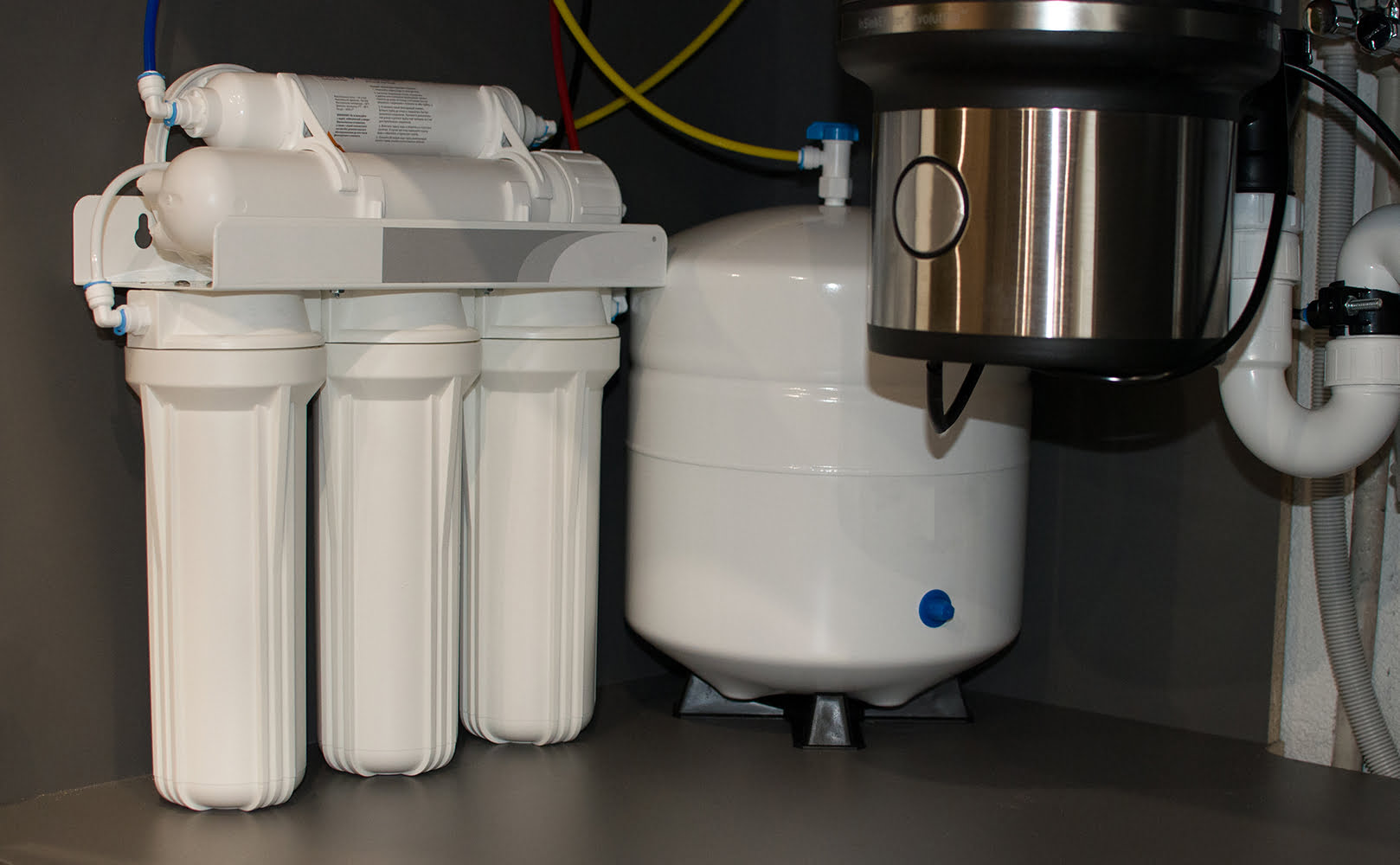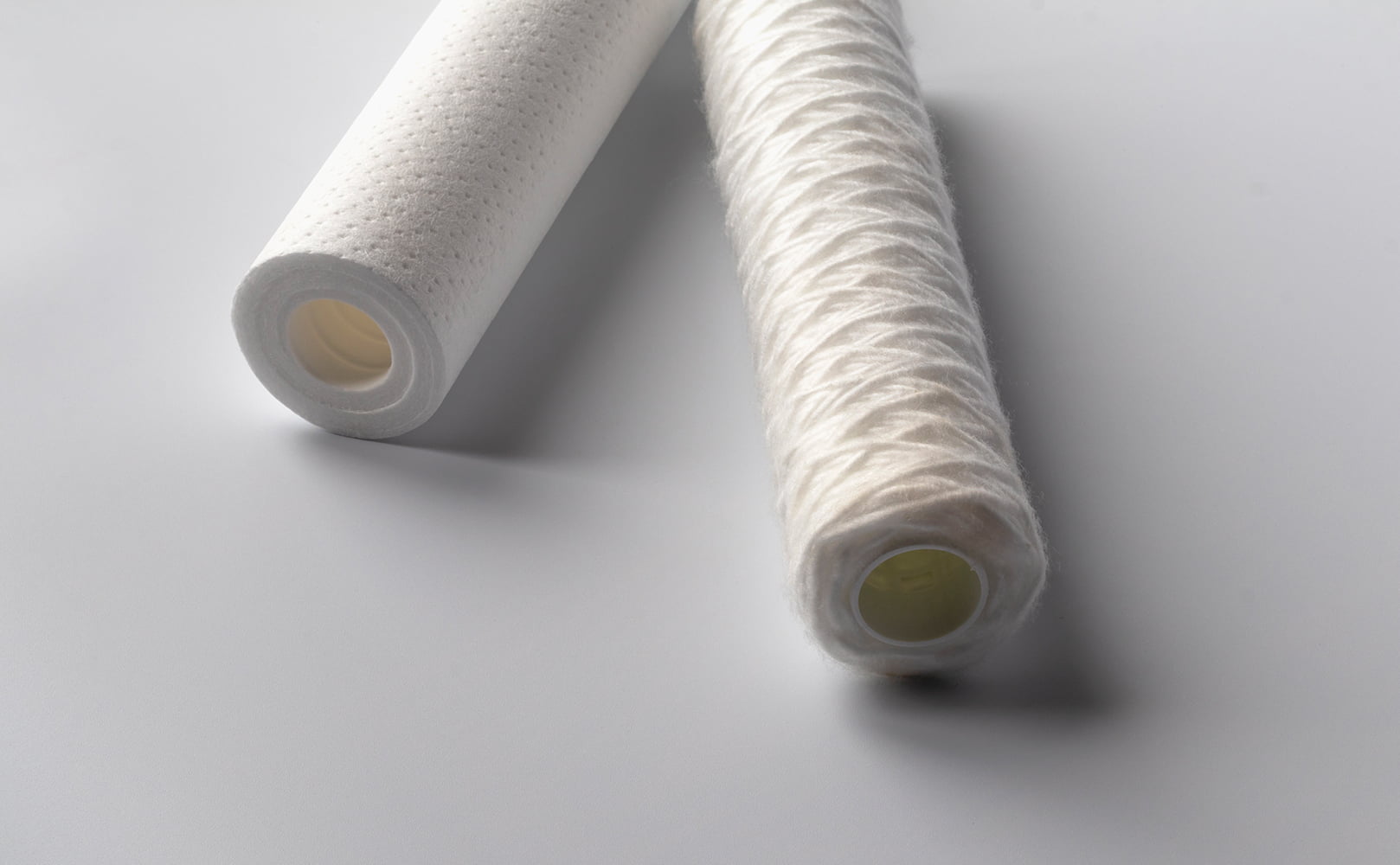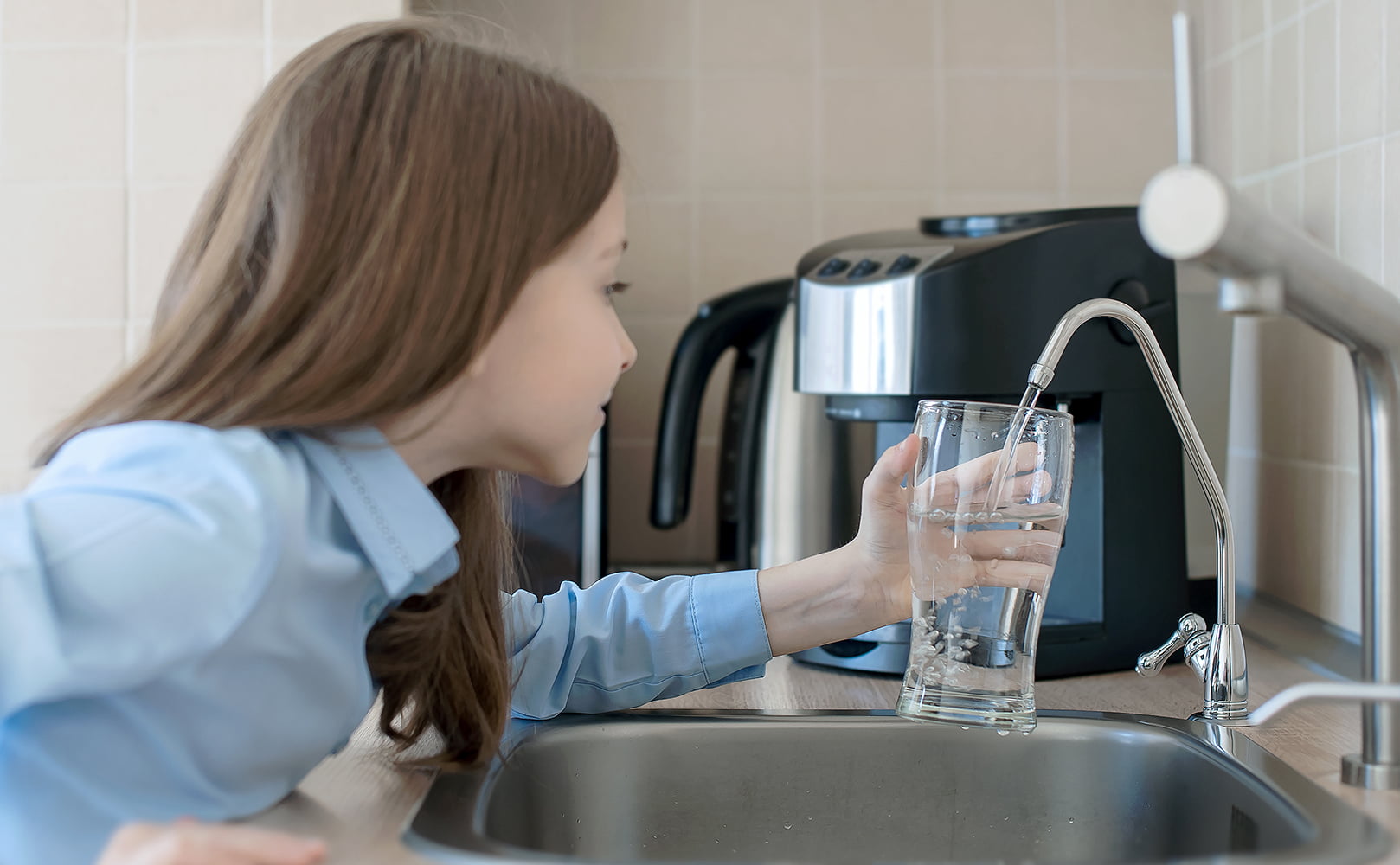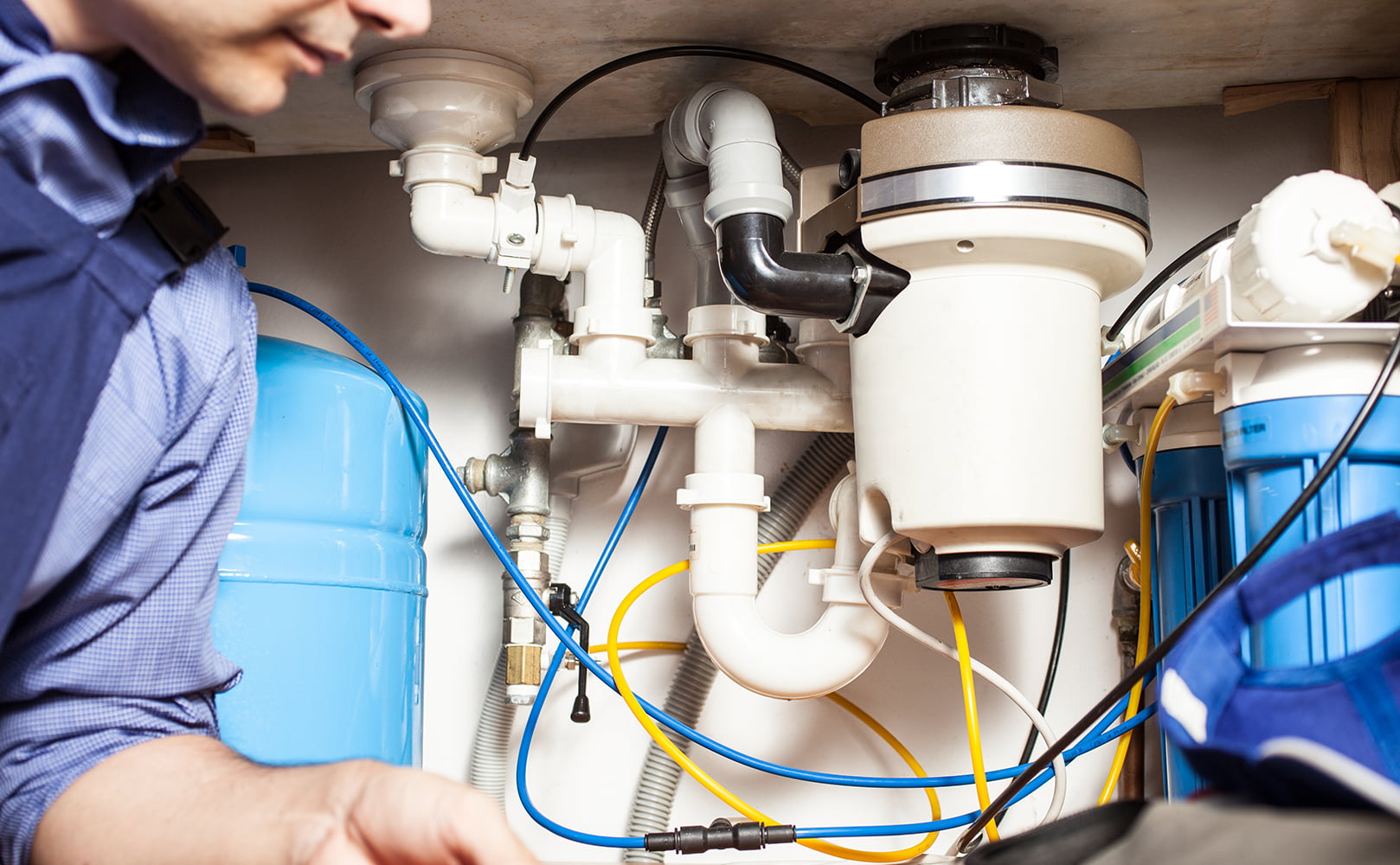What Is a Reverse Osmosis System and How Does It Work?
Written by: Gene Fitzgerald // Last Updated: May 3, 2023
This page may contain affiliate links. If you buy a product or service through such a link we earn a commission at no extra cost to you. Learn more.
Reverse osmosis systems are widely considered one of the most effective water filtration devices today. These systems remove a wide range of contaminants – resulting in clean, fresh-tasting water whenever you need it.
While the term reverse osmosis may be somewhat familiar if you have any knowledge of water treatment, there is a lot to unpack when it comes to how these systems operate.
Let’s take a deeper look at the reverse osmosis process, how RO systems operate, and what you need to know when considering a system for your home.
Key Takeaways
- Reverse osmosis systems are considered one of the best (drinking) water filtration methods available – and with good reason. They use multiple pre and post-filter stages in addition to the RO membrane to achieve an impressive level of contaminant reduction.
- For the reverse osmosis process itself, RO systems use water pressure to force feed water through an ultra-fine membrane which captures any contaminants over .0001 microns.
- Sediment and carbon pre/post-filters are used to remove floating particles and chemicals like chlorine/chloramine.
- The two types of RO water systems for home use are point-of-use and point-of-entry systems. Point-of-use systems are typically installed underneath a sink – and only filter water at a single access point. Point-of-entry systems filter water for the entire home.
- Reverse osmosis systems differ from other water filter types in that the RO membrane doesn’t trap any contaminants, rather it separates the water into two streams. One is contaminant-filled wastewater which is flushed down the drain, and the other is filtered water that passes on to the RO faucet.
What Is a Reverse Osmosis System?
So, what is a reverse osmosis system?
A reverse osmosis system, or short RO system, is a multi-stage water filter designed to remove nearly all contaminants from your home’s feed water by combining several water filtration methods and filter media; reverse osmosis being one of them.
The multi-stage design makes RO systems highly effective. Plus, it ensures pollutants/impurities that could harm the delicate reverse osmosis membrane are removed before they can reach it.
RO systems generally feature at least three stages but often have four or more:
- Typically, there are two pre-filters – a sediment filter and an activated carbon filter – designed to remove specific contaminants before they have the opportunity to foul the primary RO membrane. As you might expect, the sediment pre-filter removes large particles of silt, sand, and rust etc. The carbon pre-filter is there to remove chlorine/chloramine – both of which can damage the RO membrane.
- All RO systems have a reverse osmosis membrane as their primary filter stage. This stage is the main workhorse of the setup and uses very fine pores to separate contaminants from clean water.
- Lastly, most RO systems for home use will have a carbon post-filter to ‘polish’ the water’s taste and smell, removing any residual contamination.
How Does a Reverse Osmosis System Work?
How does a reverse osmosis system work? And what does a reverse osmosis system do precisely?
The idea behind reverse osmosis systems is the use of water pressure to force water through the ultra-fine RO membrane – which captures even the tiniest contaminants. RO membranes are made of an ultra-fine mesh capable of trapping almost any contaminant larger than .0001 microns – which means they will capture microbial contaminants, heavy metals, pesticides, and much more.
The most common type of RO system sold today are point-of-use systems. These systems are usually installed underneath a kitchen sink and only filter drinking water dispensed through a separate faucet on the countertop. As point-of-use systems only filter drinking water, they are efficient and relatively easy to maintain.
Contrast that with whole house or point-of-entry reverse osmosis systems – which filter the entire water supply for your home. These systems sound good in theory, but as they have much greater maintenance and operating costs, they tend to be prohibitively expensive for most people.
There are also countertop models, which sit on top of a countertop and work much in the same way as under sink units.
Osmosis Explained
The term reverse osmosis can be a little confusing as the process differs significantly from the typical scientific use of the term osmosis.
Osmosis is a natural process in which water from a weaker saline solution will migrate through a membrane into a stronger saline solution in order to balance out salt concentrations in both solutions. Examples of this are how plants absorb water from the soil or how your skin will become pruned if you sit in a bath for a long time.
What Is Reverse Osmosis?
Reverse osmosis is essentially osmosis in reverse. It uses external water pressure to push the water from the stronger saline solution (the unfiltered water) through the membrane and into the weaker saline solution (the filtered water).
As this is the opposite of the naturally occurring osmosis process, it requires the use of energy (in the form of pressure), otherwise, reverse osmosis would not work. This is also why RO systems will not work properly if the feed water pressure is too low.
The membrane is sandwiched in between the reverse osmosis process and serves to trap the contaminants and dissolved solids on the waste side of said membrane. This ‘waste water’ is then discarded down the drain through a drain line.
RO System Components and How They Work
Below is a list of all the essential RO system components and how they work.
Feed Water Valve
The feed water valve is the valve connecting the RO system to the cold-water supply under your sink. Whole house systems will be connected directly to the home’s main water line and use a different valve type.
Pre-Filter Stages
As mentioned before, pre-filter stages are used to remove certain contaminants before they can reach the RO membrane. The two primary contaminants which must be removed for the RO membrane to function properly are sediments and chlorine/chloramine.
That’s why pretty much all reverse osmosis systems feature two pre-filter stages: A sediment filter and an activated carbon filter.
RO Membrane
The RO membrane is the primary filter stage of any RO system. It’s an ultra-fine semi-permeable membrane that removes a wide variety of impurities from water – down to just .0001 microns.
Storage Tank
Because RO systems filter water at a very slow rate, they usually require the use of a storage tank to keep enough water on hand to fulfill your needs.
RO storage tanks are pressurized for the tank to send water when it is needed throughout the system. The tank also uses pressure to trigger the automatic shut-off valve, which tells the system when to start filtering water and when to shut off again.
Post-Filter Stages
After the RO storage tank comes one final filter stage before the water gets dispensed. This post-filter is to remove any residual taste or odor that may have entered the water during storage.
Automatic Shut-Off Valve
The ASO prevents water from entering a reverse osmosis system once the storage tank is full. Without an ASO, water would constantly flow down the drain line which would be a huge waste.
Check Valve
The check valve prevents water from flowing backwards towards the reverse osmosis membrane. Water flowing backwards could damage an RO membrane.
Flow Restrictor
A flow restrictor is part of the drain line and prevents excessive water wastage. It also maintains pressure inside the RO membrane. housing
Drain Line
The drain line connects the RO system to the drain.
RO Faucet
RO systems come with their own separate faucet for dispensing the purified water.
How the Different RO Filter Stages Work
Let’s take a closer look at the operation of the different reverse osmosis filter stages and how they work to remove contaminants.
Sediment Pre-Filter
Sediment filters are typically the first pre-filter stage and are used to remove large particulates which can clog the later filter stages. These filters work like a strainer – separating the large particles of sand, silt, and sediment from the remaining feed water.
Sediment pre-filters are typically either surface filters or depth filters.
Surface filters use a thin sheet to trap particles on their surface and often use a pleated accordion-like structure to give them greater surface area.
Depth filters pass water through a thicker wall of filter media, with a filter removing sediments throughout its depth.
Activated Carbon Pre-Filter
Activated carbon pre-filters are primarily used to remove chlorine and/or chloramine from feed water. Chlorine/chloramine are common disinfectants used in municipal water treatment (water disinfection), but they will also damage your RO membrane if they aren’t filtered out.
Carbon filters also have the additional benefit of removing foul odors and tastes, and other contaminants like VOCs, heavy metals, and disinfection by-products.
Activated carbon filters are typically granular activated carbon or activated carbon block filters. Granular activated carbon is a loose granular carbon while carbon blocks are made of powdered carbon bonded together into solid blocks.
Most carbon pre-filters are not the highest-end form of carbon filter – catalytic carbon. This is generally not an issue though, as the RO membrane will remove an incredibly high degree of contaminants.
RO Membrane
The RO membrane uses a simple but highly effective process to remove impurities from water.
Feed water enters the membrane housing after having passed through the first two pre-filter stages. Due to the high pressure within the membrane, water is forced to diffuse through the pores on the membrane, trapping contaminants on the ‘waste’ side of the membrane.
At this point, water is separated into two streams – one with clean water that flows onto the storage tank, and the other with contaminant-filled water which flows down the drain line and into the drain pipe of your sink.
Activated Carbon Post-Filter
Finally, an activated carbon post-filter is used to ‘polish’ the water’s aesthetics and taste. This filter is typically a carbon block filter and is usually the last stage before filtered water is dispensed through the RO faucet.
How Is Reverse Osmosis Different from “Regular” Water Filtration?
Reverse osmosis differs from typical water filtration in several ways. Most water filter systems, whether they are cartridge-based or tank-based, pass water through a filter that traps contaminants and then sends clean water onward for use.
Reverse osmosis membranes, on the other hand, do not trap contaminants, but rather reject them. They separate the water into two streams: One clean, and the other contaminant-filled. The clean water is sent up into the storage tank or up to the faucet for drinking while the contaminant-filled water is routed down the drain for disposal.
This filter design allows reverse osmosis membranes to remove a heavy concentration of contaminants without becoming clogged. RO membranes typically have a lifespan of 2 to 5 years, as unlike typical filters, RO membranes don’t accumulate most of the removed contaminants.
Reverse Osmosis vs Water Softening
Reverse osmosis is a broad-spectrum contaminant removal process. That means it will remove a wide array of contaminant types from water, but more on this later.
Water softening, on the other hand, is designed to reduce water hardness – which is the accumulation of hard minerals like calcium and magnesium. Water softeners will typically replace these hard minerals with softer minerals like sodium through a process known as ion exchange.
Water softening won’t remove anything other than hardness minerals, so it’s not much of a water filter at all. The benefit of a water softener is that hard water can cause scale buildup inside your home’s plumbing and reduce the lifespan of your appliances.
Now, reverse osmosis systems will remove hardness minerals from your water as well, but they aren’t designed for this purpose. Running hard water through an RO system is hard on the membrane, and will lead to clogging sooner than later.
If your area has hard water and you’re considering reverse osmosis, then it’s worth considering installing a water softener before the RO system.
What Contaminants Will Reverse Osmosis Remove from Water?
Owing in large part to its ultra-fine membrane, reverse osmosis systems are capable of removing a wide range of contaminants from feed water. When you add in the pre and post-filter stages, you have a system capable of removing everything from sediment to heavy metals and microbial contaminants.
RO systems will remove the following contaminants:
- Sediment, silt, dirt, and rust
- Chlorine and chloramine
- Disinfection byproducts
- Pesticides and herbicides
- VOCs
- Bacteria, viruses, cysts, and protozoa
- All kinds of metals including aluminum, chromium, arsenic, lead, and copper
- Salts and minerals
- Asbestos
- Radioactive elements like radium and uranium
It’s important to note that although RO systems are incredibly effective against a broad spectrum of contaminants, they won’t remove everything.
Additionally, as reverse osmosis systems are so effective, they will remove some beneficial minerals along with harmful contaminants. There is a relatively simple solution to this though – adding a remineralization filter to add back the beneficial minerals that were stripped away.
What Is Not Removed by Reverse Osmosis?
No single water filtration method is 100% effective, and even reverse osmosis has its weak points.
The following contaminants are not removed by RO alone:
- Dissolved gasses such as radon, carbon dioxide, and chlorine are not effectively removed by an RO membrane. This includes the common but troublesome gas hydrogen sulfide which is naturally occurring in well water. Some of these contaminants will be removed by the carbon pre-filter – another reason why pre-filtration is so important.
- Certain pesticides like atrazine and trichlorobenzene – will be removed by carbon filter media.
- Organic compounds such as benzene and trihalomethanes – will be removed by carbon filter media.
The Pros and Cons of Reverse Osmosis Drinking Water Systems
Reverse osmosis drinking water systems are superb at removing a wide range of contaminants, but they aren’t perfect and come with some drawbacks as well.
Let’s take a detailed look at the pros and cons of RO water systems to give you a better idea of whether they are right for you.
Pros
Contaminant Removal
Without a doubt, reverse osmosis systems are one of the most thorough types of water filters available. They remove a broad range of both organic and non-organic contaminants.
Better Tasting Water
Reverse osmosis’s advanced filtration means you’re left with incredibly clean and neutral-tasting water. Not only does RO remove potentially harmful contaminants, but it also eliminates the overwhelming majority of sodium and other minerals which can give water an off-taste.
The carbon pre and post-filters serve to further enhance water aesthetics.
Healthy Drinking Water
As RO strips nearly everything from your water except for H2O molecules, you’re left with nearly 100% pure water. Not only does RO water taste incredibly clean and pure, but as potentially harmful contaminants are removed, any health concerns that you might have had should be alleviated.
Easy to Install and Maintain
Despite being multi-stage filter systems, RO units – especially under-the-sink units – are relatively easy to install and maintain. Most can be installed on your own without hiring a professional in less than two hours.
As far as maintenance is concerned, all that’s required is changing the sediment and carbon filters every 6 months or so, replacing the RO membrane every 2 to 5 years, and periodic cleaning and sanitizing of the tank/system. The precise filter-changing schedule will depend on the specific system in question – so it’s best to consult the manufacturer’s recommendations.
Customizable
Many RO systems feature a modular design that allows you to add optional filters depending on your specific requirements.
If you’re handy with DIY, then you can also build your RO system from scratch using parts available from water filter suppliers. You won’t save a significant amount of money by going this route, but it will enable you to tailor-make the system to fit your preferences.
Filtered Water on Tap
RO systems utilize a storage tank to keep enough filtered water on hand to meet your immediate needs at all times. As the filtration process is slow, a tank is needed to keep a reserve available.
A bonus of having a large storage tank is that you won’t need to wait for the water to pass through the system. Unlike gravity and pitcher filters, RO systems will automatically refill themselves every time you pour water out of the faucet.
Affordable
While reverse osmosis filter systems are not exactly cheap, once the system is purchased and installed, the ongoing maintenance costs are minimal. If you compare this with the cost of constantly purchasing bottled water, for instance, then it doesn’t take long to recoup your initial investment.
Cuts out Bottled Water
If you’re currently purchasing bottled water, then acquiring an RO will not only save you money, but it will cut back on the significant waste associated with bottled water. Plastic bottled water is a significant environmental concern, so reducing the use of this plastic is a bonus of purchasing reverse osmosis.
Cons
Reverse Osmosis Wastes Water
As a consequence of the filtration process, wastewater is produced by any reverse osmosis system. This is an unavoidable part of the process. The standard ratio is approximately 4 parts waste to one part filtered water.
There are a few things you can do to reduce or recycle this wastewater though. Adding a permeate or pressure pump onto the system will reduce the wastewater ratio by as much as 90%. Wastewater can also be redirected to a storage tank rather than down the drain, and then reused for household tasks like car washing, watering plants, laundry, etc.
Mineral Loss
One side effect of the reverse osmosis process is that both good and bad particles are removed by the RO membrane. This means that even healthy minerals like magnesium, potassium, and calcium are stripped away from the water.
The good news is that drinking water is not a significant source of mineral intake for people, and minerals derived from water only make up about 5% of our daily intake.
If this is still a concern for you, keep in mind there are remineralization filter stages that can add healthy minerals back into your water before it comes out of the faucet. Alternatively, you can use mineral-rich salts or a mineral blend to remineralize manually.
Filtration Speed
As mentioned previously, RO systems filter water at a slow pace, which is the reason they utilize a storage tank. Generally speaking, the slow filtration speed is not a problem, as the tank will automatically refill itself every time you pour water from the faucet.
If you find that your system is running slowly, then there may be an issue with a clogged filter or a clogged RO membrane.
Space Requirements
A typical under sink RO water system takes up about 2 foot by 2 foot of space for the whole unit with the storage tank. You may not have the necessary space under your sink if the cabinet is on the smaller side – but the system can also be installed in a nearby cabinet if necessary.
Extra Faucet
Under sink systems use a secondary faucet to dispense water on the sink top. This means you may need to drill a hole through the sink or countertop if you don’t have a spare hole for a soap dispenser or spray hose.
Drain Connection Required
As reverse osmosis filtration systems must have a way to flush away wastewater, they need to be hooked into the drain pipe beneath your sink. This isn’t a major downside, but it does mean you’ll need to drill a hole in your sink’s drain pipe to install the drain saddle.
Flat Taste
This one isn’t a major con, but some people find RO water to be flat tasting when they first start drinking it. This is because all the impurities have been removed, so you’re left with exceptionally neutral-tasting water.
What to Consider When Shopping for an RO System
NSF Certifications
NSF certifications are the best way to ensure that contaminant reduction claims made by the manufacturer are accurate.
- Standard 42 tests water filtration systems for “aesthetic effects”. The main contaminant covered by this certification is chlorine – a commonly used disinfection chemical in municipal water treatment. Particulates affecting water aesthetics are also covered.
- Standard 53 tests for the removal of water contaminants with “health effects”. This means contaminants with known health effects regulated by the US EPA. This includes heavy metals, cysts, volatile organic compounds (VOCs), and more.
- Standard 58 is a standard specifically for point-of-use reverse osmosis filtration systems. It covers a range of criteria including materials safety, structural integrity, efficiency rating, recovery rating, and contaminant and overall TDS reduction.
- Standard 401 is the standard measuring the reduction of “emerging compounds”. These are chemicals and pharmaceuticals that may have health effects but are not yet regulated by the EPA. This includes bisphenol A (BPA), estrone, ibuprofen, naproxen, nonylphenol, phenytoin, TCEP, TCPP, meprobamate, metolachlor, linuron, and trimethoprim.
Whenever you’re considering an RO system, it makes sense to look for NSF certifications. Without NSF certification, there is no way to ensure the contaminant reduction claims other than testing them yourself.
Filter Stages
RO systems come in several different configurations and feature different filter stages designed to remove different contaminants.
Some of the commonly used filters:
- Sediment pre-filter: Sediment pre-filters are designed to remove sand, silt, sediment, and other large particle contaminants. Nearly every reverse osmosis water system will have some form of sediment pre-filter, as it’s necessary to remove larger contaminants so they can’t clog the RO membrane.
- Activated carbon pre-filter: Carbon pre-filters are another filter type found on nearly every RO system. Carbon filters remove chlorine/chloramine from water – another contaminant that will foul the RO membrane. These filters also remove foul odors/tastes, certain heavy metals and most organic chemicals, and sometimes microbes if the micron rating is low enough.
- Carbon post-filter: Carbon post-filters are common, but not found in every RO system. They will remove any remaining foul odors and tastes and polish the water before it’s ready to drink.
- UV filter: UV light filters are used to kill any microbial contamination in water. These filter stages use a UV bulb to often eradicate over 99.9% of microbes like bacteria, viruses, cysts, and protozoa. While RO membranes will remove a large proportion of microbial contamination, they aren’t designed for this purpose and can harbor bacteria in some cases. UV filter stages are typically an optional filter stage added as one of the later stages and are recommended for well-sourced water – which is more prone to microbial contamination.
- Remineralization stage: Remineralization filter stages are used to add back beneficial minerals after water has passed through the other filter stages. As RO filters strip nearly everything from your feed water, the final product will not feature significant amounts of minerals like magnesium, potassium, and calcium. A remineralization stage will add these back into your water – restoring its pH balance.
Installation and Maintenance
Another important consideration when looking at any reverse osmosis system is the ease of installation and maintenance.
- Countertop RO systems are extremely easy to install. They only require a simple water line connection to a standard kitchen faucet, or they are filled manually.
- Under sink units are slightly more complex to install, but generally speaking, they can be installed on your own provided you have basic DIY skills and plumbing knowledge.
- Whole house reverse osmosis systems are the most complex to install, and although they can be installed on your own, hiring a plumber to ensure the installation is completed correctly is often recommended.
As far as maintenance is concerned, most RO systems are fairly simple to maintain. Generally, the only maintenance tasks required are changing the filters and membrane on schedule, annual cleaning/sanitizing the system using a cleaning solution, and ensuring the tank pressure is sufficient.
Water Usage
Your water use requirements will dictate the system size you’ll require. Typical under sink units can filter between 10 and 75 gallons per day (GPD), while whole house units can filter much more, in the 500 to 5000+ range. Of course, whole house systems must be able to filter much more, as they filter all of the water flowing into your home.
One more thing to keep in mind is that the actual production level will be between 50% and 75% of the stated GPD number.
Water Pressure
Another consideration is the water pressure required for a reverse osmosis system to operate properly. Most systems will work best at 60 psi, and require a minimum of 40 psi to work at all.
Low water pressure causes the system to create excess wastewater, which means your filter will be working at a lower than optimal speed.
If the water pressure in your home is too low, there is a simple solution, however. Installing a booster pump will increase the feed water pressure– increasing it to the optimal level.
Budget
While RO systems provide superb filtration, they aren’t as costly as you might think. You can purchase a quality under sink or countertop filter for just several hundred dollars. Whole house setups, on the other hand, cost in the thousands, which is one reason they aren’t generally recommended for most situations.
When considering the cost of a system, be sure to factor in the cost of filter and membrane replacements in your calculations. A typical system will run you between $50 and $250 annually to maintain.
Wastewater Ratio
The wastewater ratio refers to the ratio of wastewater generated to filtered water produced. A typical system has a wastewater ratio of 4:1 – meaning a significant amount of wastewater is created. Pumps can reduce this ratio to 1:1 or even better.
Remineralization
As mentioned previously, reverse osmosis will strip essential minerals from your water in addition to contaminants. This is not a serious cause for concern, as minerals from water represent a tiny amount of our daily mineral intake, but if you prefer the taste of mineralized water then consider adding a remineralization stage.
How to Install and Maintain a Reverse Osmosis Filter System
Countertop and under sink reverse osmosis water filtration systems can usually be installed using basic tools and a little DIY knowledge. Manufacturers will provide detailed installation instructions pertaining to your unit, however, you can always hire a plumber or contractor to complete the installation for you if you wish.
Countertop units require almost no installation other than a simple hookup to a kitchen sink faucet in most cases.
To install an under sink unit:
- The first step will be mounting the RO faucet on the sink or countertop. Many sinks have a spare hole for installing a soap dispenser or spay hose, which can often be repurposed for housing the RO faucet. If not, you’ll need to drill a hole through the sink or countertop using a specialized bit.
- Next, you’ll need to install the feed water valve which supplies water to the filter system. This involves shutting off the cold-water supply, connecting and tightening the T-valve, and then turning the cold-water supply back on.
- Next comes the storage tank installation. This involves finding an appropriate location with enough space, positioning the storage tank, and connecting and tightening the tank valve.
- At this point, you’ll need to hook up the various tubing connections on the system. Many RO systems have color-coded tubing, so making the correct connections is fairly intuitive. You’ll need to cut some of the lines to the correct length to avoid kinks and bends in the tubing.
- Next up, insert the pre and post-filters into their housings as well as the RO membrane into the membrane housing.
- Lastly, you’ll need to start the system and flush it several times before the water is ready to drink. This is because the carbon filters will generate residue the first few times they are used.
Maintenance for RO systems falls into three categories: Filter and membrane changes, sanitizing and cleaning, and ensuring correct storage tank pressure.
- Generally speaking pre and post-filters will need to be changed every 6 to 12 months. The membrane itself will typically last between 2 and 5 years before it needs replacement. Again, be sure to consult your manufacturer instructions for precise recommendations.
- Sanitizing and cleaning the system is necessary to prevent biofilm and bacterial buildup within the filter housings and storage tank. The tank is particularly susceptible to this, so it must be cleaned/sanitized regularly. The process involves removing the filters and membrane from their housings, adding a small amount of disinfecting solution to the first pre-filter, and then flushing water through the system to move the cleaning solution throughout the entire system. Sanitizing and cleaning should be done every 6 months or so, so completing it at the same time you complete filter changes makes sense.
- The last maintenance task is ensuring the pressure inside your RO storage tank is adequate. These tanks use internal pressure to send water to the RO faucet, so if the tank’s internal pressure drops it won’t be able to send water up the tubing effectively. To repressurize a tank, you’ll need to empty it, and then add pressure via the pressure valve until it reaches 6 to 8 psi.
How Long RO Systems Last
RO systems will last an average of 10 to 15 years provided they are well-maintained and serviced regularly. This figure refers to the lifespan of the system itself and the individual filter and membrane components which have much shorter lives.
Additionally, your usage level will influence the system’s lifespan – if you’re running a high volume of water through it, the lifespan will be reduced. This is especially true for water with high levels of dissolved solids or hard water.
RO Water vs. Bottled Water
If you’re currently purchasing bottled water for drinking, then purchasing a reverse osmosis water filter system is going to provide you with several immediate benefits.
Firstly, bottled water is expensive. Even if you are purchasing the cheapest bottled water you can find, the costs will be significant. If you compare that with the high up-front cost but the lower long-term cost of running an RO system, then you’ll realize that RO systems are more economical over the long term.
As an example, let’s say a family of 4 purchased bottled water at a cost of $3 per gallon and consumes 2.5 gallons total per day. For an entire year that will cost $2737.50.
Contrast that with the cost of an under sink RO system. Let’s say the system costs $350, the cost of filter replacement for the first year is $60, and the tap water cost is $3.38 per 1000 gallons x 4 (for wastewater). For the entire year, the total will be $423.52.
So, for the first year (the most expensive year) you’ll be looking at a cost savings of $2313.98. The following year will have even greater cost savings, as the most expensive cost – the reverse osmosis system – will already have been paid off.
In addition to the significant cost savings, you’ll also be drastically reducing your use of plastic waste, which is great in terms of environmental impact. Additionally, you won’t need to worry about chemicals leeching into your water – which can be a serious concern where bottled water is used.
If you have any thoughts about the questions, what is an RO system and how do reverse osmosis systems work, please don’t hesitate to leave a comment below!
Information provided on BOS is for educational purposes only. The products and services we review may not be right for your individual circumstances.
We adhere to strict editorial guidelines. Rest assured, the opinions expressed have not been provided, reviewed, or otherwise endorsed by our partners – they are unbiased, independent, and the author’s alone. Our licensed experts fact-check all content for accuracy. It is accurate as of the date posted and to the best of our knowledge.







